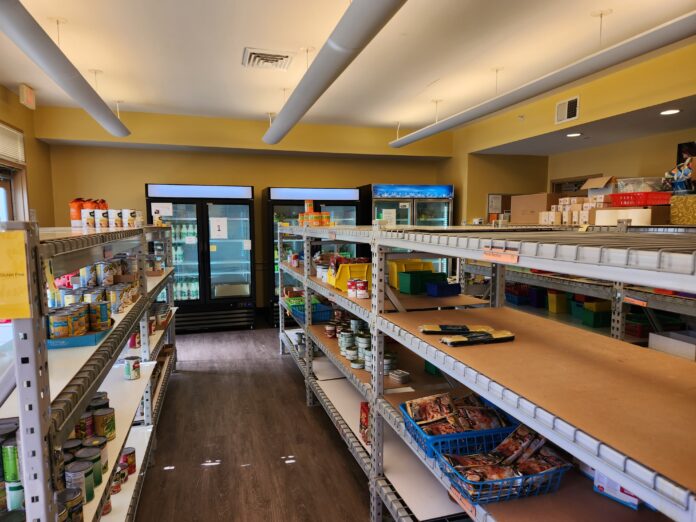
Tucked away in a corner on Rowan University’s campus and squeezed in between the hulking, yellow-and-brown Rowan Boulevard Apartments, The SHOP operates in hopes of aiding the population of Rowan students who face food insecurity — a population The SHOP estimated to be roughly 48% of undergraduate students on campus.
Established in 2017, The SHOP is Rowan University’s on-campus food pantry and resource center that not only aids students facing food insecurity but meets other needs such as winter clothing, hygiene products and school supplies.
The setup is reminiscent of a small grocery store, showcasing multiple aisles filled with produce and non-perishables, and a refrigerated area in the back containing milk and microwaveable meals.
“We have a lot of really great stuff. From meat and milk and fresh produce and pastries,” said Becky Foster, The SHOP coordinator. “And so people have really been enjoying that.”
The SHOP is open on Monday and Friday each week and, according to its website, serves approximately 100 members of the Rowan community per day. However, over The SHOPS’ eight days of operation in September, the food pantry reported a total of 1,413 visits — an average of 176 visitors per day. Of these visits, there were 774 unique individuals.
Because of this increase in visitors, The SHOP had to place limitations on what they can provide to students during their visits. What was once a “take what you need” operation now has several constraints, such as students only being able to take one bag full of groceries, only being able to spend 10 minutes in The SHOP and only being able to visit once a week.
“This semester there’s been way more people and it’s hard to keep the shelves stocked with everyone coming in,” Rhys Ancheta, who’s been volunteering at The SHOP since 2020, said. “It’s great that we’re getting a lot of people coming in but it’s hard when we don’t have the resources for as many people as there are.”
The SHOP has made strides in hopes of curbing these limitations, such as the $100,000 Hunger-Free Campus Grant the center secured from the New Jersey Office of the Secretary of Higher Education. This grant will be used to relocate The SHOP into a house—notably larger than the single-room space the center operates from in Building 5 of Rowan Boulevard Apartments—and, according to Foster, expand into a “true resource center.”
Foster hopes to relocate The SHOP in the near future, as the house was found to be plagued by structural issues when relocation was attempted during the summer.
“We were supposed to move into a new, bigger space over the summer, but some red tape happened there,” Foster said.
While this would have allowed for a higher capacity of students to be in The SHOP, as well as provide space for various resources, the discrepancy between students’ needs and what The SHOP can provide likely would have prevailed.
“Our supply is the same,” Foster said. “But since we have twice as many people taking the same amount of stuff, it just means there’s a lot less.”
This issue isn’t unique to The SHOP, however. Stacy Ferraro, site coordinator of the food pantry at the Samaritan Center of Glassboro, reported a similar struggle.
“During COVID, we saw an increase of people coming in. And then also, now I think because food prices are so high…they can’t get as much in the store,” Ferraro said.
According to Ferraro, the Samaritan Center saw a total of 360 people during the month of September and noted that it was difficult for the center to keep food on its shelves as prices rise.
Ferraro added that she often had to frequent the grocery store twice a week to keep the center’s necessities, such as juice, canned vegetables and cereal, in stock. This was paid for by donations made to the Samaritan Center.
Despite the need for increased supply, coordinators of The SHOP and the Samaritan Center of Glassboro remain hopeful that they can continue to help their patrons to the best of their ability.
“If students are food insecure, they often have other needs as well,” Foster said. “We’re always happy to talk with students and try and give them more resources that are appropriate for their situations.”
For comments/questions about this story tweet @TheWhitOnline or email thewhit.newseditor@gmail.com.





